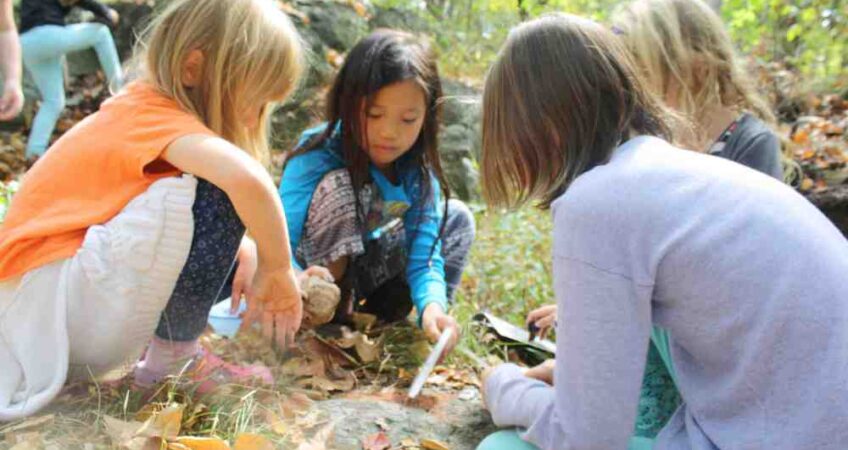
Earth School – Digging in the Dirt: No Doodling Allowed?


When did removing children from nature become a form of punishment? Or is it meant to make nature an incentive for obedience within a system whose requirements are unreasonable? What are children being trained for exactly?
My intention with this blog has always been to present the alternatives, the bright side of what is possible, the genuine attempts that are being made to set things right in an educational system that I feel is out of balance in the United States. It was always my dream to effect change, one mind at a time, one backyard at a time, and no offense is ever meant. There are great teachers in every kind of school in the world, and there are not so great teachers. This blog is called “Digging in the Dirt,” because from time to time I think we need to expose the issues underlying the situation for education in America today, so that we can open up the discussion about how to improve that situation and make a better place for our children now, one that can also last into the future.
So I invite you to think about your first day of school…
If you can remember, what did you do on your first day of school?
What did your classroom look like?
What did it smell like?
How did you feel inside of it?
What were you learning in those first few years?
Who were your favorite teachers?
Why were they your favorites?
Did you have art classes?
Where did they take place?
What kinds of materials were you using?
Every day for the past 18 years that I have been teaching Earth School for homeschoolers (part-time, farm-based education programs), I am in awe because of what these children have that I did not and always wished I had. “Lucky is the child who goes to Earth School,” intones one of the parents whose child has attended our programs for the past 7 years. One of my favorite quotes comes from just last week, from a 5-year-old girl who complained,
“The only thing that I don’t like about Earth School is that I can’t come every day.”

My favorite memory of going to elementary school was the walk to school in the morning through the woods. I went to public school in Hastings-on-Hudson, NY, and my walk to Hillside Elementary (I balked totally at taking the smelly school bus that was full of teasing and bullying) took me through suburban forest, where the early morning dew and mist consoled me, the rabbits, deer, and chipmunks enchanted me, the smells of the wet earth and the sound of songbirds cheered me. I remember every year how it felt on the last day of school (I remember almost nothing we learned whatsoever, and am not sure that I actually did learn anything in my first few years), when I would sit down in the grass on the way home, munching on wild onions, and singing to myself, “No more pencils, no more books!…” There was this feeling of freedom every time I pushed that door from the school out into the fresh air for the summer, and I was free, free to breathe, free to run, free from the smell of stale milk, free from the fear of dank toilets.

So I imagined for the whole of my life a school where children were in nature, instead of staring out the window of the classroom at nature. And I don’t mean setting up chairs and tables in nature. That’s not an outdoor classroom, that’s tables and chairs outdoors. An outdoor classroom means using the logs as walkways, the pond as science experiments, the rocks as blackboards, the grass as carpets. This is therapeutic horticulture, and even if one attends a public school, it can have a garden instead of a blacktop schoolyard or instead of an empty rooftop. Many schools already have gardens, but they often plunk down raised beds in squares to teach scientifically and mathematically about planting and the origins of food and healthy eating and soil composition, but tend to skip the integration of creative writing and journaling and social studies. As our art teacher once rejoiced about teaching environmental art outdoors at Earth School: “No more chalk and talk!”
One of my joys is reuniting with Earth School students in the years that pass after they have graduated from our farm-based and forest-centered classes and entered the public or private school system. I always ask them what is their favorite aspect about their new school, and what is their least favorite. What invariably erupts is an outpouring of distress over the lack of outdoor time, and the use of “detention” for minor infractions that just keep children indoors during recess, as a punishment.
How upside down this thinking is. And we know it! So why don’t we object more vociferously? Let me tell you the stories told to me yesterday during an apple picking trip, by an 8th grader at a Westchester County public school, and you tell me what you think…
Students are given 3 minutes to get from one class to the next, between bells. This is typical in middle schools. If a student is late by a minute or more, that equals detention. In 3 minutes, a child has to get from one end of the building to another, stopping at the locker to get books, with never enough time to use the bathroom or get a drink of water. This includes getting from gym class to an academic class. My former student, 13 years old, described how after gym she needs to change her clothes, wash off because she is sweaty (makes sense in adolescence to want to clean up after gym), get to her locker, and get all the way across the building, doesn’t have time for a drink of water, and cannot get to her next class within 3 minutes, so she repeatedly has been kept in from recess.

But the worst for me was when she told me that no doodling in your notebooks is allowed. What?! I am actually still in shock as I write this. How would I ever have survived the intoning of boring history teachers, year after year after year, had I not been allowed to doodle within the margins of my notebook? I was taking down all the notes from the blackboard, following what they said, but the doodling allowed my creative imagination to flow at the same time, and gave me the opportunity to develop my skills at drawing and calligraphy and symbology. What, I asked, is the reason that doodling is not allowed? Because, she explained with great exasperation, it means you are not paying attention. They check your book, she said, and if there is any doodling, they give you a lower grade for the year, because you are not participating. Discuss…
Finally, as I sat bumping along on a hayride, listening to my former student describe the things that make her unhappy (though she is very strong and a real fighter, so she is not broken by these things – others would be), younger children were also listening in. I was watching 6 year olds screaming with delight each time the hayride jolted them and they fell onto bales of hay with peals of laughter. They are not having enough fun, I told myself with a smile. One of the younger children who overheard the conversation and is in 4th grade in a local public school told me that she had also been kept in from recess twice, for forgetting to bring in her homework sheet signed by her parent. She told me with a shaking voice, a pale face, quivering hands, that she won’t forget to have it signed again. Gee, I thought, why don’t they just rap the children over the knuckles like they used to when you wrote your b’s and d’s backwards? At least you could still go play outside.
When did removing children from nature become a form of punishment? Or is it meant to make nature an incentive for obedience within a system whose requirements are unreasonable? What are children being trained for exactly?
It’s ok. You don’t have to answer that, but I do hope you’ll think about it. And if you’ve got thoughts to share, please leave a comment below.
